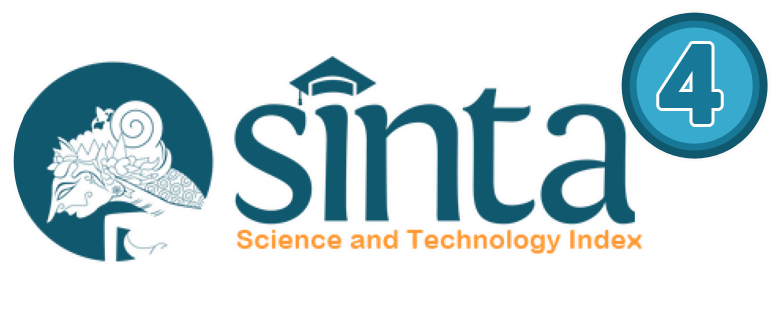Tathbîq Tiknûlûjiyâ (Istirâtîjiyah al-Kharîthah al-Dzihniyah) li Hilli Musykilah Ta'lîm Mufradât al-Lughah al-'Arabiyah Lada Thullâb al-Fashl al-Sâbi' fî al-Madrasah al-Tsânawiyah "Nurul Jadid Banyuputih - Situbondo"
 Abstract views: 290
,
Abstract views: 290
,
 PDF downloads: 327
PDF downloads: 327
Abstract
The inhibiting factor for students having difficulty in learning Arabic is that vocabulary mastery is still very limited, even though the vocabulary is an elementary language that must be mastered by foreign language learners including the Arabic Language. Therefore learning methods and strategies are very influential in the learning process and student's motivation to study. Learning strategies included in the design of domain learning technology. So the teacher in this school uses mind mapping strategies to solve the student's problem in mastering Arabic vocabulary. In this study, the researcher used a qualitative method. While the process, the researcher has a source of data from the mufradat/vocabulary learning process as well as the students involved in it. This paper discusses the implementation of learning technology (mind mapping strategy) to solve the problem of learning mufradat. And The results of this study prove that the mind mapping strategy help to improve mufradat mastery of the students and them following the learning process with pleasure.
Downloads
References
أحمد، سمية دفع الله. المشكلات اللغوية في تعليم اللغة العربية للناطقين بغيرها جامعة المدينة العالمية أنموذجية ، رسالة الماجستير غير منشورة جامعة المدينة العالمية، 2011.
الأسعد، ضحى. تكنولوجيا تعلم اللغة العربية. بيروت : مركز بيت اللغة، د. س.
البشير، مزمل ومحمد مالك سعيد، مدخل إلى المناهج وطرق التدريس. المملكة العربية السعودية : دار اللوء، د. ت.
البلوشية، نوال بنت سيف بن محمد. "فاعلية مشروع المكتبة الإلكترونية في تنمية اتجاهات مهارات القراءة الحرة لدى طالبات الحلقة الثانية،" المقالة يلقي في المؤتمر الدولي الخامس للغة العربية التاريخ 7 مايو 2016 الفترة 09.00- 12.30، ص. 161، مأخوذة من الانترنت http://www.alarabiahconference.org
بوزان، توني. كيف ترسم خريطة العقل .الرياض : ترجمة مكتبة جرير، 2008.
الحارون، شيماء . استراتيجية مقترحة في تنمية بعض المفاهيم العلمية والمهارات الوجدانية ومهارات ما وراء الذاكرة لدى تلاميذ المرحلة الإعدادية من المتفوقين عقليا ذوى صعوبات التعلم، رسالة دكتوراه غير منشورة قسم المناهج طرق التدريس، كلية التربية .القاهرة : جامعة عين الشمس، 2007.
الحديدي، على. مشكلة تعليم اللغة العربية لغير العرب .القاهرة : دار الكتاب العربي للطباعة والنشر، 1967.
الخولي،محمد على. الحياة مع لغتين : الثنائية اللغوية. الرياض : جامعة الملك سعود، 1988.
دفيانا، أدي دستري وشريفة رحمة الله. "استراتيحية تعليم علوم الحديث بضوء التفكير للطلبة في قسم تعليم اللغة العربية بالجامعة" التعريب، العدد 7 النمر 2 (ديسمبر 2019).
الطوبجي، حسين حمدي. وسائل الاتصال والتكنولوجيا في التعليم .الكويت : دار القلم، 1987.
فوطري، أيديا. " تطبيق تكنولوجيا التعليم في تصميم استراتيجيات التعليم وخصائص الطلاب في تعليم اللغة العربية،" إحياء العربية، العدد 2 (يوليو – ديسمبر 2015).
هلال،محمد عبد الغني. مهارات التعلم السريع القراءة السريعة والخريطة الذهنية .القاهرة : مركز تطوير الأداء والتنمية، 2007.
Aqib, Zainal. Model-model Media dan Strategi Pembelajaran Kontekstual (Inovatif). Bandung: Yrama Widya, 2013.
Buzan, Tony. Buku Pintar Mind Map, Terjemahan Susi Purwoko (Jakarta: Gramedia Pustaka, 2007.
Chotib, Ahmad dkk. Pedoman Pengajaran Bahasa Arab pada PTAI. Jakarta: Proyek Pengembangan Sistem Pendidikan Agama, 1976.
DePorter, Bobby dan Mike Hernacki. Quantum Learning: Membiasakan Belajar Nyaman dan Menyenangkan. Terjemahan Alwiyah Abdurrahman. Bandung: Kaifa, 2001.
Fahrurrozi, Aziz. “Pembelajaran Bahasa Arab: Problematika dan Solusinya,” Arabiyat: Jurnal Pendidikan Bahasa Arab dan Kebahasaaraban, Vol. 1, No. 2, 2014: 161 – 180.
Jumhana, Nana. “Aplikasi Teknologi Pembelajaran dalam Pemecahan Problematika Pembelajaran Bahasa Arab,” al–Ittijah, Vol. 2, No. 2, 2010: 143 – 162.
Sugiyono, Metode Penelitian Kuantitatif Kualitatif dan R&D. Bandung: Penerbit Alfabeta. 2011.
Warsito, Bambang. Teknologi Pembelajaran: Landasan dan Aplikasinya. Jakarta: Rineka Cipta, 2008.
Authors who publish with this journal agree to the following terms:
a. Authors retain copyright and grant the journal right of first publication with the work simultaneously licensed under a Creative Commons Attribution License that allows others to share the work with an acknowledgement of the work's authorship and initial publication in this journal.
b. Authors are able to enter into separate, additional contractual arrangements for the non-exclusive distribution of the journal's published version of the work (e.g., post it to an institutional repository or publish it in a book), with an acknowledgement of its initial publication in this journal.
c. Authors are permitted and encouraged to post their work online (e.g., in institutional repositories or on their website) prior to and during the submission process, as it can lead to productive exchanges, as well as earlier and greater citation of published work (See The Effect of Open Access).
Alibbaa': Jurnal Pendidikan Bahasa Arab have CC-BY-SA or an equivalent license as the optimal license for the publication, distribution, use, and reuse of scholarly work.
In developing strategy and setting priorities, Alibbaa': Jurnal Pendidikan Bahasa Arab recognize that free access is better than priced access, libre access is better than free access, and libre under CC-BY-SA or the equivalent is better than libre under more restrictive open licenses. We should achieve what we can when we can. We should not delay achieving free in order to achieve libre, and we should not stop with free when we can achieve libre.

Alibbaa': Jurnal Pendidikan Bahasa Arab is licensed under a Creative Commons Attribution 4.0 International License
You are free to:
- Share — copy and redistribute the material in any medium or format
- Adapt — remix, transform, and build upon the material for any purpose, even commercially.
- The licensor cannot revoke these freedoms as long as you follow the license terms.











